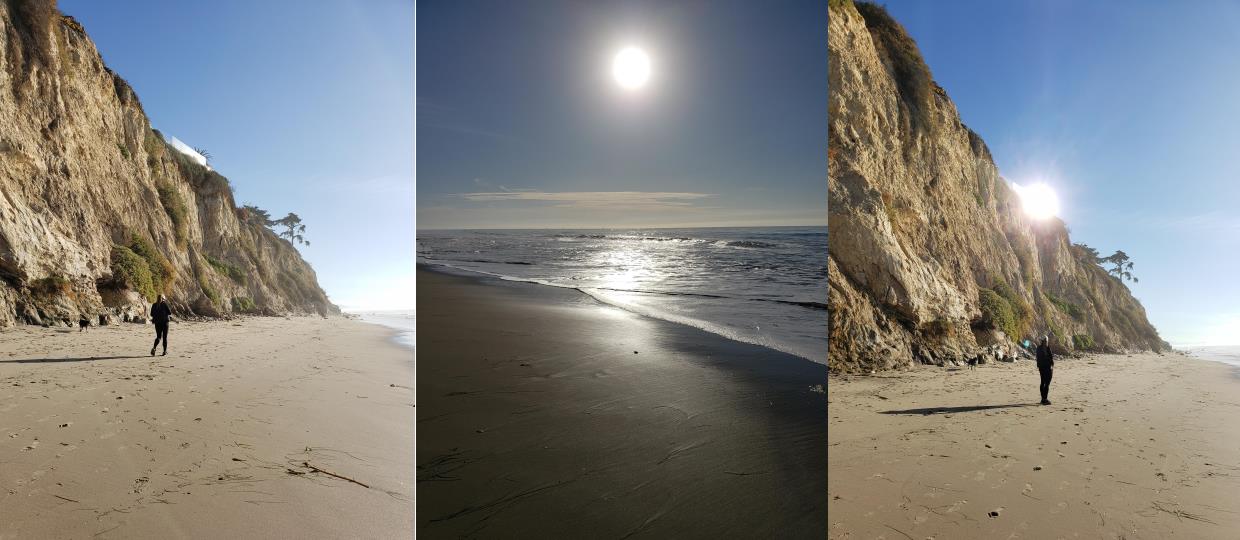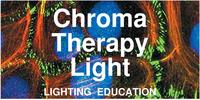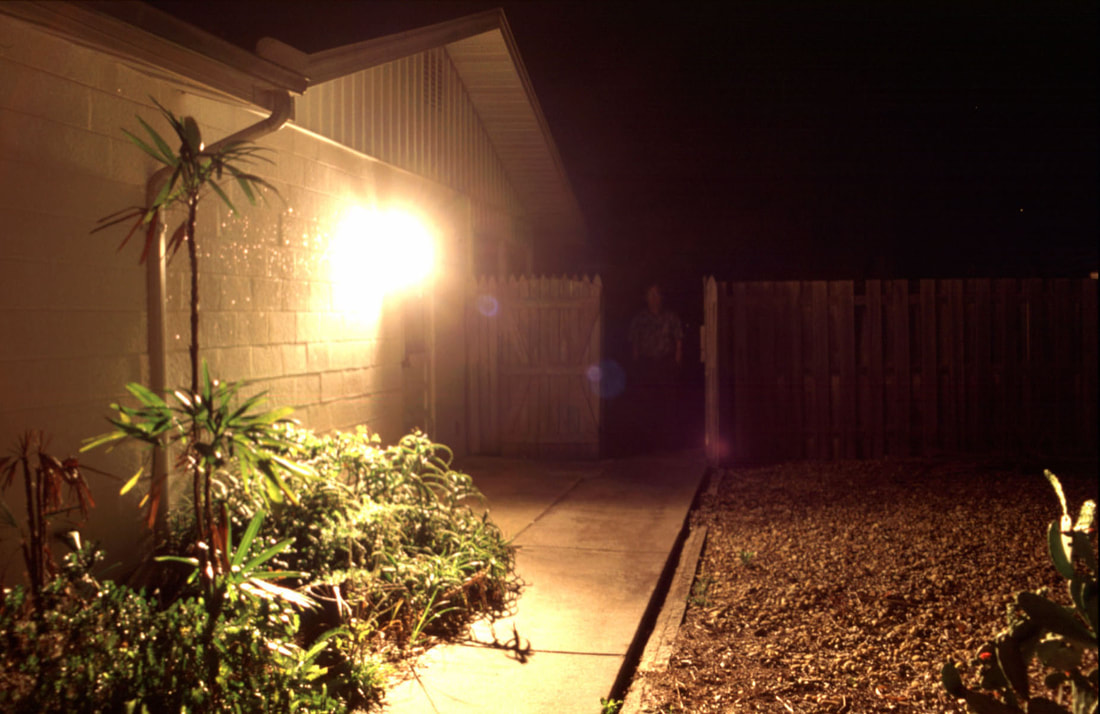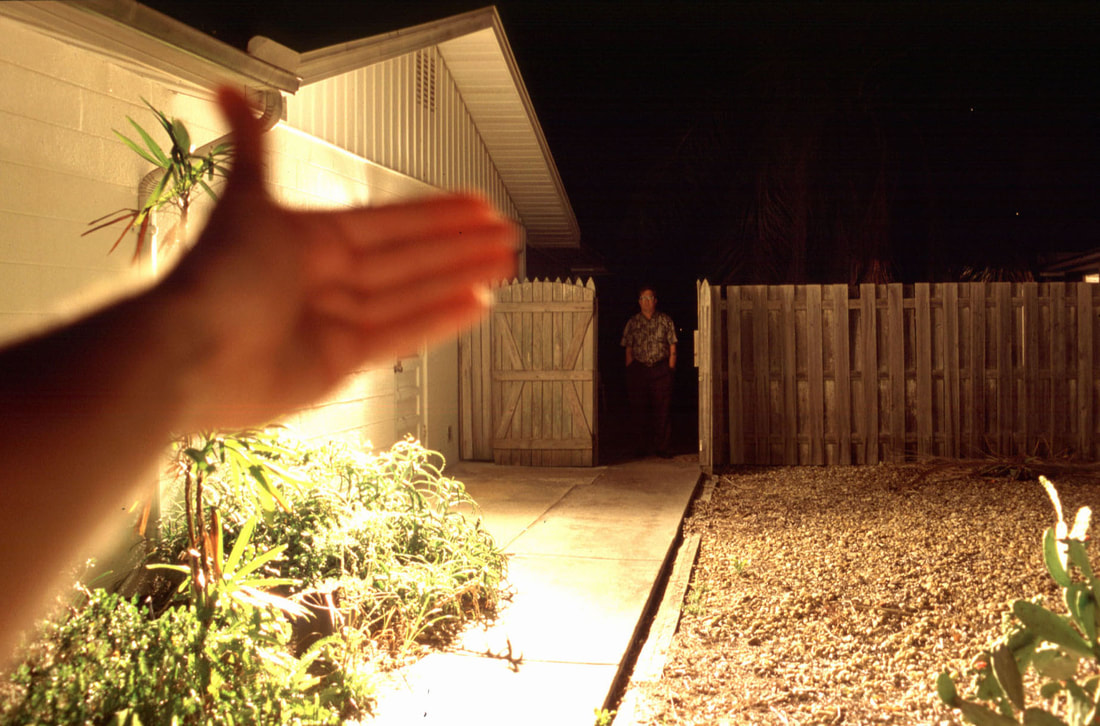LED Glare - Learning Objectives
Good lighting design should always include analysis of color rendering, light intensity, beam spread, flicker, and glare.
Too bright!GLARE = Visual Disability Due to the extremely small light source of LEDs, glare can cause visual disability - squinting and averting your eyes. Glare can also prevent you from seeing properly as shown in the Before and After photos above. Did you notice the person at the gate?
Direct Glare can cause temporary blindness.Have you ever made the mistake of looking directly into a flashlight? You cannot seen anything immediately after exposure to that bright light the filled your field of vision. This is a example of direct glare, where you are temporarily blinded by a too bright light.
Whenever your eyes see a terribly bright light, you squint, if you don't squint fast enough, you are temporarily blinded. Aging Eyes are even more debilitated by the blinding effects of direct glare. No one wants to look at the sun. With LED lights becoming so bright, and because they are a 'point source' they are especially risky when it comes to direct glare. Your peripheral vision is also vulnerable to direct glare. How to avoid Direct Glare?Several solutions reduce the risk of direct glare; shielding and diffusing.
SHIELDING - hiding the light source behind a fixture, or 'regressing' the light source far inside a fixture such as a downlight or streetlight will reduce the opportunity for direct glare. adding a cone around floodlights is another simple solution. DIFFUSING - softening the harshness of a LED light with a diffuser specifically designed to reduce the surface brightness of the LED while distributing the light over a wider area is a useful technique; however, with LEDs being overly bright, diffusing alone may not be enough to mitigate the extreme point source brightness and may also require shielding. See examples of Shielded Light Fixtures on my Dark Sky page. Lighting Design Lesson: The angle of incidence = the angle of reflection.If you think about glare like a game of billiards, the way to win is to understand that 'the angle of incidence = the angle of reflection'.
If you see a reflection of the light source in your computer, TV, window, or art - move yourself, the light source, or move the reflective surface. The two photos show the same creek. In one image you can see the rocks below the surface, in the other the reflection of the sun on the surface prevent you from seeing what is beyond. This example shows how important it is to calculate the angle of your light source and the reflections it will create. This is especially important to consider when illuminating large shiny surfaces or works of art.
|
Glare is the effect of brightness or differences in brightness within the visual field sufficiently high to cause annoyance, discomfort or loss of visual performance. Reflected glare - this photo of sunlight reflecting off of a beachfront glass railing, shows that the angle of reflection is a mirror of the angle of incidence, creating a second sun in the view. Reflected glare - this photo of sunlight reflecting off of a beachfront glass railing, shows that the angle of reflection is a mirror of the angle of incidence, creating a second sun in the view.
Glare – Disability Glare If task performance is affected, it is called disability glare Glare – Discomfort Glare Visual discomfort caused by excessive brightness is called discomfort glare. Glare – Direct Glare Glare resulting from very bright sources of light in the field of view. It usually is associated with bright light from luminaires and windows. A direct glare source may affect occupant’s performance by reducing the apparent contrast of objects in the field of view, especially those near the source of light. Glare – Indirect Glare Glare produced from a reflective surface. Glare – Reflected Glare or Veiling Reflection Glare resulting from bright reflections from polished, glossy, or illuminated objects and surfaces in the field of view. Veiling reflections reduce visual contrast and make it difficult to complete seeing tasks such as reading glossy magazines or looking through windows or at computer screens. Often windows or light fixtures will reflect off surfaces obscuring what is beneath, anticipate this visual obstacle by careful placement of lights, windows, and tasks. Remember with glare, 'the angle of incidence equals the angle of reflection' just like billiards. Visual Comfort Probability (VCP) A rating system for evaluating direct discomfort glare. This method is a subjective evaluation of visual comfort, when viewing from a specific location and in a specified direction, expressed as the percent of occupants of a space who will be bothered by direct glare. VCP allows for several factors: luminaire luminances at different angles of view, luminaire size, room size, luminaire mounting height, illuminance, and room surface reflectivity. VCP tables are often provided as part of photometric reports. See veiling reflections Since LED light sources do not mimic daylight, there is a need to have some metrics for comparison to familiar light sources of sunlight, incandescent and halogen. Lighting Facts is a good start, for more details consider the Kelvin, CRI, and TM-30 metrics.
Related Topics
Footnotes
Photo Credits
|
- Home
-
- CHROMA Topics
- Color Spectrum - Light is Energy
- Color in Light
- Color in Nature
- Color in Paint
- Why does paint fade?
- Color Names & Meanings
- Color Phenomena
- Color Perception is Individual
- Color In Fashion
- Color for your home
- Color in Space
- Color Blindness
- Color Blind Interview
- Synesthesia
- Synesthete Deborah Borrowdale-Cox
- Synesthete Stephen Orr, BH&G Editor
-
- Circadian & THERAPY Topics
- Circadian Explained
- Circadian Ganglion Cells
- Circadian Melatonin
- Circadian Animals
- Circadian Research
- Autism & Lighting for the Spectrum
- Blue Light Dimming Apps
- Red Night Lights
- Vitamin D & Light
- SAD - Seasonal Affective Disorder
- Alzheimers and Light Therapy
- Photosensitivity - Light Sensitive Drugs
- Red Light Therapy
- Sleep & Lighting
- Dreams and Second Sleep
- NASA - Lighting in Space & Undersea
- Jet Lag
- Sunglasses
- Chakras
- Crystals, Minerals, & Gemstones
-
- LIGHTing Design Topics
- UV Germicidal Disinfection Light
- LED Lighting Facts Card
- CRI - Color Rendering Index
- LED TM-30
- LED Kelvin Color
- LED LPW
- LED Flicker
- LED Glare
- OLED - Organic LED
- Human Centric Lighting
- Lighting with Daylighting
- Lighting for Healthy Buildings & Zero Net Energy
- Lighting for Healthcare
- Lighting for Horticulture
- Lighting for Hospitality & LED Retrofits
- Lighting for Museums
- Lighting for Seniors & Low Vision
- Lighting Design Tips & Codes
- Parking Lot Lighting
- Solar Lighting for Humanity & World Health
- Davis Insectary Garden
- Santa Barbara Mesa Insectary Garden
- Home
-
- CHROMA Topics
- Color Spectrum - Light is Energy
- Color in Light
- Color in Nature
- Color in Paint
- Why does paint fade?
- Color Names & Meanings
- Color Phenomena
- Color Perception is Individual
- Color In Fashion
- Color for your home
- Color in Space
- Color Blindness
- Color Blind Interview
- Synesthesia
- Synesthete Deborah Borrowdale-Cox
- Synesthete Stephen Orr, BH&G Editor
-
- Circadian & THERAPY Topics
- Circadian Explained
- Circadian Ganglion Cells
- Circadian Melatonin
- Circadian Animals
- Circadian Research
- Autism & Lighting for the Spectrum
- Blue Light Dimming Apps
- Red Night Lights
- Vitamin D & Light
- SAD - Seasonal Affective Disorder
- Alzheimers and Light Therapy
- Photosensitivity - Light Sensitive Drugs
- Red Light Therapy
- Sleep & Lighting
- Dreams and Second Sleep
- NASA - Lighting in Space & Undersea
- Jet Lag
- Sunglasses
- Chakras
- Crystals, Minerals, & Gemstones
-
- LIGHTing Design Topics
- UV Germicidal Disinfection Light
- LED Lighting Facts Card
- CRI - Color Rendering Index
- LED TM-30
- LED Kelvin Color
- LED LPW
- LED Flicker
- LED Glare
- OLED - Organic LED
- Human Centric Lighting
- Lighting with Daylighting
- Lighting for Healthy Buildings & Zero Net Energy
- Lighting for Healthcare
- Lighting for Horticulture
- Lighting for Hospitality & LED Retrofits
- Lighting for Museums
- Lighting for Seniors & Low Vision
- Lighting Design Tips & Codes
- Parking Lot Lighting
- Solar Lighting for Humanity & World Health
- Davis Insectary Garden
- Santa Barbara Mesa Insectary Garden









